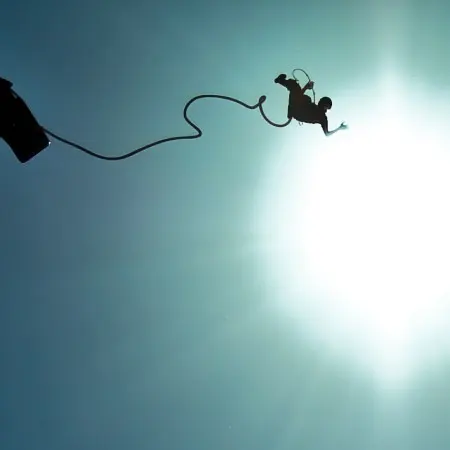Jumping off a bridge with nothing but a stretchy cord for safety may seem dangerous and foolish, but a crazy stunt like this need not be made by blind faith. By taking a look at the physics behind the extreme sport of bungee jumping, this method of obtaining an adrenaline rush may start to make more sense - and perhaps even seem appealing.

According to the Law of Conservation of Energy, energy cannot be created or destroyed. However, it can change forms. Bungee jumping is all about this change. While standing on a bridge, platform or hot air balloon, a jumper has gravitational potential energy. After jumping, this potential energy turns into kinetic energy.
While the bungee cord is slack, the participant will experience a downward acceleration that exceeds free-fall acceleration. This is caused by the mass of the bungee cord added to the weight of the jumper. As the cord looses slack and begins to stretch, energy is converted to the elastic potential energy of the cord.
Hooke’s Law of Elasticity, discovered by English scientist Robert Hooke in 1660, explains the amount of force required to restore the bungee cord to its original position of equilibrium. This law is extremely important for bungee jumping calculations. It helps operators determine how much tension a cord can withhold and the maximum length it will stretch. If the force is within the elastic limit, it will eventually recoil to its original size.
When calculations are incorrect, complications can occur. For example, if the force acting on the cord is too great, the stretching of the cord will exceed elastic limits. This excessive stretch can cause the cord to become distorted and not return to its original form, potentially causing harm.
With the proper equipment and calculations, the bungee cord will stretch until it recoils, bringing the jumper back up into the air. This occurs when the force of the bungee cord pulling up on the jumper exceeds the force of gravity. This repeats until the jumper has stopped bouncing and is now dangling in the air.
Using Hooke’s Law of Elasticity, the relation between the length of an elastic object, the applied force, and the length of stretch can be understood. In the sport of bungee jumping, this law is applied to ensure safety. With the proper equipment, calculations and technique, anyone, no matter their shape or size, can experience a smooth, safe jump - even if the jumper is confined to a wheelchair.